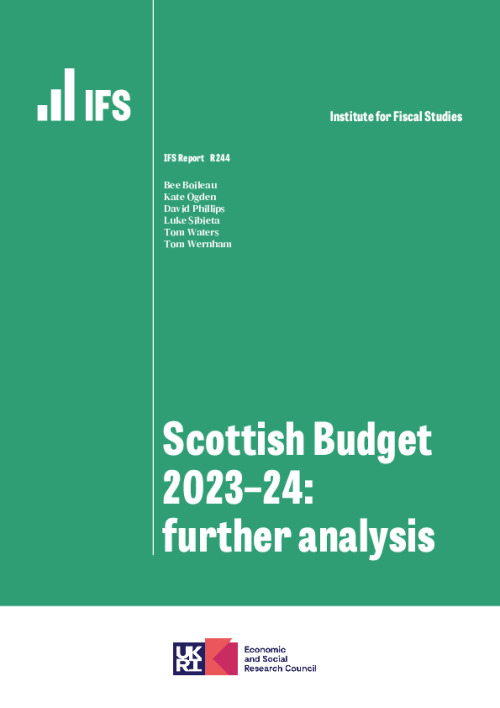The Scottish Government’s Budget for 2023–24 takes place at a difficult time for households, businesses and public services. High inflation, driven by energy and food price increases, is reflected in a forecast UK-wide 7% fall in household disposable income over the two calendar years, 2022 and 2023 (Office for Budget Responsibility, 2022). The resulting fall in demand, and tighter financial conditions following increases in interest rates is leading to an increase in businesses going under (Insolvency Service, 2023). And increases in the costs of purchases, higher-than-planned-for wage increases and labour unrest are putting public services – already struggling to recover from the COVID-19 pandemic – under strain.
Given all this, the headline increase in spending set out in the Scottish Government’s Budget for 2023–24 may seem comforting: 3.9% in real terms compared with the current financial year. However, spending on recently devolved and new social security benefits, such as the Adult Disability Payment and Scottish Child Payment, is set to absorb over half this increase. Recipients of these payments will see a boost to their incomes, but it also means tighter budgets elsewhere. Comparing the Budget for 2023–24 to the initial Budget for 2022–23 for non-benefit spending only, the increase is 1.6% – and this ignores in-year top-ups to the Scottish Government’s Budget during the course of 2022–23, with extra funding provided to the NHS, local government, and to cover police and fire service pension costs, among other things. Taking account of these top-ups, the budget for non-benefit spending in 2023–24 is currently set to be 1.6% lower than in 2022–23; or 0.8% lower, after stripping out the effect of one-off policies such as the council tax rebate. Even this is likely to understate the financial pressures that Scottish public services will face, as the measure of inflation used to calculate real changes in public spending does not fully account for rising energy and food prices (as it excludes the cost of imported goods and services).
Even so, the budget for the coming year is still more generous than what was expected at the time of the Scottish Government’s Resource Spending Review in May 2022. Additional funding from the UK government of £800 million, following top-ups to planned spending in England, as well as an improvement to the forecast net funding contribution from Scotland’s devolved taxes of a similar magnitude, mean an additional £1.5 billion is available from April compared with the indicative plans set out in the Resource Spending Review.
Nearly all services have seen a boost to planned spending compared with the indicative plans set out in that Review. Health, and the ‘net zero, energy and transport’ portfolios are notable winners, with funding for local government (including schools) still set to fall in real terms after adjusting for in-year top-ups in the current financial year and changes in councils’ responsibilities.
The Budget also continues a trend of increases in taxes on higher-earning Scots to help fund more generous social security benefits and public service spending – although the high levels of spending (and the resulting greater levels of service provision) relative to England remain largely down to extra funding received from the UK government via the block grant.
The aim of this report, the IFS’s first in-depth analysis of the Scottish Government Budget, is to look at some of the key implications for the coming year, and for the longer term. We do not attempt to cover all of the different services that the Scottish Government is responsible for, or all revenue streams, but instead look at those issues most pertinent to current political and public debates. We therefore focus on the overall funding outlook, income tax revenue performance, local government funding, and the distributional effects of tax and benefit reforms.
The rest of this report proceeds as follows.
In Section 2, we look at the overall funding outlook for the Scottish Government, considering the short, medium and long term in turn. We find that a forecast improvement in the performance of Scotland’s devolved tax revenues relative to the rest of the UK will, if it materialises bolster funding over the next few years. However, significant growth in spending on devolved social security benefits will absorb a large part of this, and funding for non-benefit spending is set to fall over the next two years and then grow only modestly in the period to 2027–28. The Barnett formula is also likely to deliver smaller percentage increases in funding for Scotland than will be provided to England, making it increasingly difficult to maintain the higher levels of public service provision that Scotland currently enjoys.
Section 3 looks in more detail at devolved income tax revenue performance, highlighting the importance of past and forecast changes in employment and earnings in Scotland relative to the rest of the UK.
Section 4 considers funding for Scottish councils and schools, which overall fell by less during the 2010s than in England, but is set to increase by significantly less in the coming year than south of the border.
Section 5 presents our analysis of the distributional effects of the Scottish Government’s income tax and social security benefit policies – looking at both changes over time and comparisons to the rest of the UK.
Section 6 offers some brief concluding remarks.
As discussed in the note at the start of this report, we have been unable to account for additional funding for teachers’ pay announced on 14 February 2023. This reflects both the late announcement of this funding and a lack of detail on the source of this funding and how it is being distributed across years.
References
Insolvency Service (2023), ‘Commentary – monthly insolvency statistics December 2022’, https://www.gov.uk/government/statistics/monthlyinsolvency-statistics-december-2022/commentary-monthly-insolvency-statistics-december-2022.
Office for Budget Responsibility (2022), ‘Economic and fiscal outlook – November 2022’, https://obr.uk/efo/economic-and-fiscal-outlook-november-2022/.
Note on additional funding for teachers’ pay
On the evening of 14 February 2023, after we had finalised this report, the Scottish Government announced that £156 million of additional funding would be provided to councils in 2022–23 and 2023–24 to improve the pay offer for teachers1 . Some news outlets, including the BBC, reported that this was part of a broader £300 million package of funding to support the pay award for other council staff in 2023–24 too2 .
The implications of this for our analysis of the outlook for overall funding for non-benefit spending and the outlook for local government specifically depend on the source of this new funding and how it is allocated over time. For example, if this is funding reallocated from other services in-year, our estimates for overall funding in 2022–23 and 2023–24 would still hold. However, if it were paid for using additional funding that has become available since the Budget bill was presented, our estimates of the real-terms change in funding between 2022–23 and 2023–24 would be biased downwards. Finally, if it has been found from expected underspends in 2022–23 that will be carried forward to 2023–24 via the Scotland Reserve, this would mean that our estimates of the year-on-year change in funding are further downwardly biased; this is because not only would funding in 2023–24 be higher than in the current Budget bill (and our analysis), but also funding actually utilised in 2022–23 will be lower than assumed.
Unfortunately, at the time of publication, the Scottish Government has not provided information on the source of this funding, or its allocation across years. We have therefore been unable to update our analysis of the overall and local government funding outlook in Chapters 2 and 4. The presentation of our findings delivered at our Scottish Budget event3 does illustrate how our estimates would be affected by different scenarios for the source of this extra funding (assuming the total is the £300 million reported by the BBC). Broadly speaking, this shows that rather than there being a modest real-terms reduction in overall and local government funding in 2023–24 relative to 2022–23, the additional funding for pay may mean that there could be a small increase, especially if it has been funded by underspends in 2022–23. However, this would still pose challenges for service delivery. Moreover, the medium-term outlook is largely unaffected by this one-off funding announcement: funding would fall back in 2024–25 and then follow the path set out in this report.















